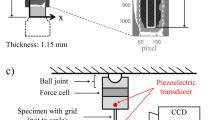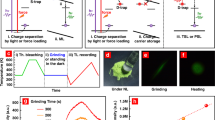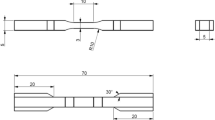Abstract
The term thermoelastic effect refers to the coupling between mechanical deformation and the change in thermal energy of an elastic material. The first theoretical treatment of this phenomenon is attributed to Lord Kelvin1, and the resulting law states that the rate of change in temperature of a dynamically loaded body is directly related to the rate of change of the principal stress sum under adiabatic conditions. Although Kelvin's law has been well known for over a century, it is only in the past ten years that the thermoelastic effect has been exploited as a means for dynamic stress analysis. A system known as SPATE (stress pattern analysis by measurement of thermal emission) has been developed which can detect changes in infrared emission due to minute changes in the temperature of a dynamically stressed material. Recently it was discovered that the SPATE response or, more generally, the thermal response of a cyclically loaded body is not only a function of the dynamic part of the stress, but also of the static component2. This finding has led to the suggestion that residual stresses within a material might be detected using this phenomenon, and here we present the first demonstration of such a means of residual stress measurement.
This is a preview of subscription content, access via your institution
Access options
Subscribe to this journal
Receive 51 print issues and online access
$199.00 per year
only $3.90 per issue
Buy this article
- Purchase on Springer Link
- Instant access to full article PDF
Prices may be subject to local taxes which are calculated during checkout
Similar content being viewed by others
References
Thompson, W. (Lord Kelvin) Trans. R. Soc. Edinb. 20, 261–288 (1853).
Machin, A. S., Sparrow, J. G. & Stimson, M.-G. Strain 23, 27–30 (1987).
Wong, A. K., Jones, R. & Sparrow, J. G. J. Phys. Chem. Solids 48, 749–753 (1987).
Wong, A. K., Sparrow, J. G. & Dunn, S. A. J. Phys. Chem. Solids (in the press).
Fisher, M. J. & Herrmann, G. Rev. Progr. Quant. NDE 3B 1283–1291 (1984).
Hirao, M. & Pao, Y.-H. J. Acoust. Soc. Am. 77, 1659–1664 (1985).
Author information
Authors and Affiliations
Rights and permissions
About this article
Cite this article
Wong, A., Dunn, S. & Sparrow, J. Residual stress measurement by means of the thermoelastic effect. Nature 332, 613–615 (1988). https://doi.org/10.1038/332613a0
Received:
Accepted:
Issue Date:
DOI: https://doi.org/10.1038/332613a0
This article is cited by
-
Analysis of the temperature evolution in cyclic loading using the thermoelastic effect with plastic deformation
Journal of Mechanical Science and Technology (2024)
-
Thermoelastic Stress Analysis in the Presence of Biaxial Stresses in Titanium: Effect of the Mean Stress on Errors in Stress Evaluation
Experimental Mechanics (2023)
-
Influence of Second-Order Effects on Thermoelastic Behaviour in the Proximity of Crack Tips on Titanium
Experimental Mechanics (2022)
-
Data Correction for Thermoelastic Stress Analysis on Titanium Components
Experimental Mechanics (2016)
-
The Potential for Assessing Residual Stress Using Thermoelastic Stress Analysis: A Study of Cold Expanded Holes
Experimental Mechanics (2013)
Comments
By submitting a comment you agree to abide by our Terms and Community Guidelines. If you find something abusive or that does not comply with our terms or guidelines please flag it as inappropriate.



